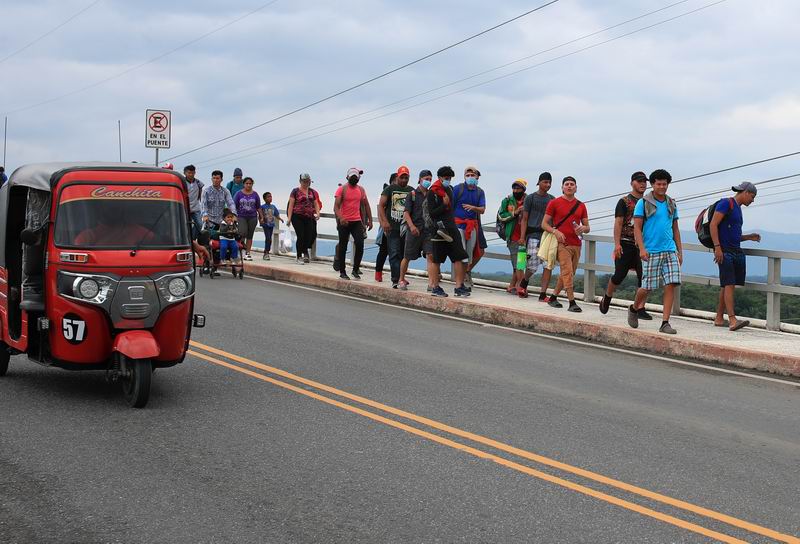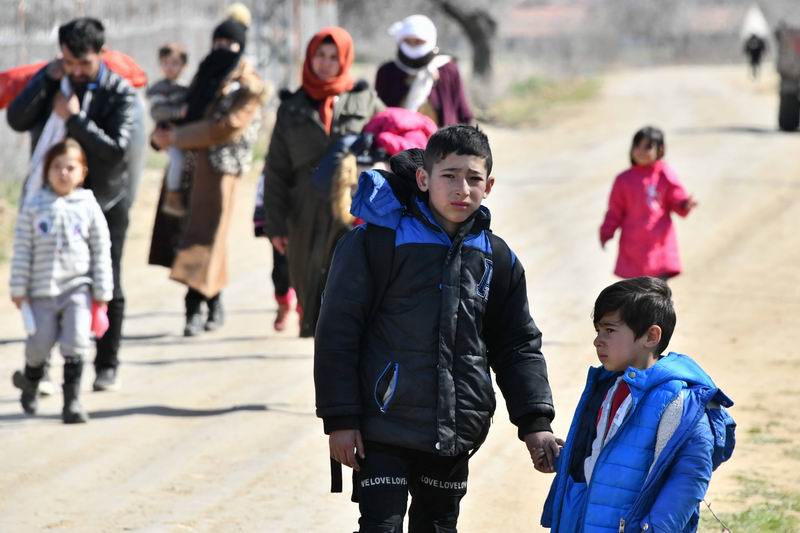Editor’s note: In the past few months, the novel coronavirus has caused serious harm to Europe and the United States; long before the outbreak of the epidemic, some European and American countries had developed antipathy towards immigrants.
Some anti-immigrant voices believe that migrants take jobs, are unable to integrate into the local culture, and even regard migration as a social destabilizing factor. However, in the process of fighting the epidemic, many migrant workers have become the backbone of society in medical care, developing vaccines, and providing digital services to facilitate people in the epidemic.
On the other hand, more and more migrant workers from Eastern Europe are returning to their hometowns amid the epidemic due to the desire for family members, and realize that the gap in living standards between Eastern and Western Europe is narrowing. Eastern European politicians say that the return of migrant workers will have a positive impact on the future development of the country.
This article is an excerpt of two articles from Foreign Policy. The first article, “Coronavirus is killing Westerners, and immigrants have saved them”, shows the contribution of migrant workers in the epidemic and the exclusionism they fight against; the second article, “The Crisis of Immigration Loss in Western Europe” focuses on the migrant workers in the epidemic. The wave of homecomings and the positive impact of returnees on Eastern Europe.
Coronavirus is killing Westerners, and immigrants are saving them.
Early testing results for the vaccine show that the effectiveness of the novel coronavirus vaccine developed by BioNTech and Pfizer has exceeded 90%. If a vaccine proves safe and can be quickly approved by regulators, it can save many lives, restore people to normal lives, and inject a shot of heart into the struggling economy.
It is hard to imagine what other invention can provide such a huge direct impetus in the present moment – for this, the world will thank the Turkish immigrants in Germany.
Ugur Sahin is the co-founder and CEO of a German biotech startup. After his father participated in the postwar guest worker program as an automobile worker, the whole family came to Germany. Ozlem Tureci, chief medical officer of biotechnology, is Sachin’s wife. She is the daughter of a Turkish doctor who also came to Germany as an immigrant.
Both later became scientists. Their startups had previously focused on developing innovative cancer treatments, and now German biotech companies will be the first to develop vaccines using new messenger RNA technology.
In addition, the test results of the vaccine of moderna, a US biotechnology company, have shown satisfactory efficacy. It is composed of two immigrants: Canadian biologist Derrick Rossi and Lebanese-born scientist and investor Nuba Afeyan (No ubar Afeyan co-founded, its CEO is French.
Sachin and Touresi’s achievements are even recognized or even celebrated by President Donald Trump (he seldom has any good comments on immigration, let alone praise), which exposes the fallacy of anti-immigrant rhetoric in Europe and North America.
Although many anti-immigrants prefer highly skilled immigrants to other immigrants; however, considering that many rich governments are increasingly favoring skills-based immigration policies, Sachin and his family are difficult to accept “now Germany”.
In fact, if he hadn’t moved to Germany when he was a child, the world might never have realized that he had missed something. Despite his talent, he would not have achieved so much if he had not emigrated to Germany, benefited from excellent science education, and did not seize the greater research and business opportunities provided by Germany.
A vaccine for the coronavirus, jointly developed by the American pharmaceutical company Pfizer and the German biotechnology company BioNTech, London, England, November 17, 2020.
In the wake of the coronavirus pandemic, with restrictions on international mobility due to public health, many locals unable to work, and an increasing number of people who believe that immigration is no longer needed, Trump has cut the number of work visas provided by the United States on economic grounds.
But as I explained in my new book, They and Us, the great contributions of Sachin and Turech are a powerful example of why this policy is wrong and harmful. Imagine what they would achieve if those who were refused entry were accepted.
Since the beginning of this year, many people have been working from home, and many people have been imprisoned at home. At this time, enterprises founded by immigrant entrepreneurs play a key role in supporting economic and social development.
Zoom, a video conferencing platform popular all over the world, was founded by Eric Yuan, a Chinese immigrant; DoorDash, the most popular food delivery application in the United States, was also founded by Tony Xu, a Chinese-American immigrant; and Deliveroo, the corresponding British food delivery app, was founded by Co-founded by William Shu, an American Chinese-American entrepreneur, Babylon Health, a British start-up that allows doctors to provide online consultation for patients, was founded by Iranian-born Ali Passa.
Overall, the pandemic has accelerated the adoption of digital technologies by businesses and households, and the founders of companies providing solutions for these technologies are often born abroad.
Nearly half of Silicon Valley technology startups, including Google and Tesla, are co-founded by immigrants. Similarly, 9 of the 14 unicorn companies in the UK have a valuation of $1 billion or more, including Babylonian Healthcare. Throughout the field of science and technology, foreign workers have made great contributions. Of the American residents with a doctorate in computer science, 58% were born abroad; while 60% of highly skilled workers in Silicon Valley are immigrants. Toronto’s technology center and London’s fintech cluster are also driven by foreign talents.
Migrants also provide a large number of medical services. In Australia, more than half of doctors were born abroad; 38% of doctors in British hospitals are immigrants, while nearly 30% of doctors in the United States are immigrants.
On the other hand, many nurses are also immigrants. Among these foreign-born nurses include “Jenny from New Zealand” and “Louis from Portugal”, who took care of British Prime Minister Boris Johnson during his hospitalization in April, and he also thanked the two nurses for “saving his life”. Older people in nursing homes are also increasingly cared for by foreign caregivers; in Italy, immigrants account for more than half of the number of care workers.
It’s not just migrant entrepreneurs and skilled immigrants who are helping society cope with the coronavirus crisis, but society is also very dependent on low-income migrant workers to perform basic manual labor, which many previously called “unskilled” manual labor.
These workers are so-called key workers who are responsible for selecting and packaging food, stacking supermarket shelves, providing door-to-door delivery and working hard in Amazon warehouses; they are also responsible for cleaning hospitals and maintaining public transportation.

Bus drivers drive on the streets of New York, United States, September 2020. The unemployment rate in the United States continued to decline in August, but it is still not as good as before the epidemic.
More and more people have moved around the world for decades, but this year’s migration has stalled, and many have returned home. But with the vaccines of Pfizer-BioNTech and other companies, the economy is likely to start to recover in 2021 and rebound with the demand for migration. The biggest question is whether and when does the government allow people to move? If allowed, who will the government allow to move?
It is often easier to implement containment than to lift it. Even after the pandemic, many governments may delay lifting restrictions on public health grounds. But within the EU, people can move freely between all 27 member states, and once the local blockade is lifted, the migration wave is likely to quickly “recur a comeback”.
After the UK leaves the EU in January this year, it will also end its right to freedom of movement as EU citizens by the end of this year, thus depriving British citizens of the freedom to move anywhere in the EU. Shame and ironically, Britain’s new immigration policy that favors skilled immigrants will deny entry many immigrant nurses, paramedics and other key workers with low wages, and UK government ministers have been out weekly to clapping for these workers during the first lockdown. The new policy will exacerbate the shortage of medical personnel and care workers, harming the health and lives of the British.
In recent years, Trump has set a terrible example for the whole world. His vicious remarks against immigrants – such as slandering Mexicans as “homicides” and “rapists” and formulating cruel policies, including banning immigration from several major Islamic countries, reducing the number of refugees, and in the United States.
The Mexican border forcibly separates children from their parents, locks them in cages like animals, etc. In addition to these morally angry policies, Trump imposed restrictions on temporary work visas this year at a time when the American technology industry is extremely short of talent, which directly hurts the economy. Canada is already taking advantage of this opportunity to open doors for foreign scientific and technological workers.

Honduran people entered Guatemala in early October and are reported to seek to enter Mexico and go north to the United States in the future. This is the first large-scale “immigrant caravan” team from Central America after the outbreak of the coronavirus.
Fortunately, President Joe Biden promised to repair the damage caused by Trump after his election. But if the Republicans hold the Senate, then full-scale immigration reform is unlikely; on the other hand, Biden has promised to repeal Trump’s many executive orders on immigration, thus ending child detention, lifting the Muslim ban, restoring refugee quotas, and allowing more technology to be temporary. Worker enters.
For the first time in four years, the U.S. government will set a positive example on immigration and derive economic benefits from it. Conversely, if countries such as the United Kingdom choose to exclude immigrants, it may hinder the country’s recovery after the epidemic.
The crisis of migration loss in Western Europe
Sverengler is a small city in Bulgaria with a population of about 18,000, located on the border with Turkey. It is famous for two very profitable industries: casinos and customs. Like many other small cities in Central and Eastern Europe, the population here has been rapidly lost due to migration in recent decades.
But this spring, something unexpected happened: the city ushered in a population surge.” The immigrants have returned from all over the world, mainly from Western Europe,” said Anastas Karchev, mayor of Svelengrad, in a telephone conversation in November.
This does not mean that Sverengler became Las Vegas overnight, immediately attracting many British or French gamblers. Instead, the city is just one of many places affected by the coronavirus “migration”. As the epidemic spread, the calm tsunami swept the eastern part of the continent.
At the end of March, this trend was first manifested. At the time, a Bulgarian official involved in the pandemic response announced that tens of thousands of Bulgarians had returned home this month.
By the beginning of summer, thousands of Ukrainians had returned home. A similar wave swept through the region.
To understand the true scale of return, my team in the Sofia office of the European Council on Foreign Relations in Bulgaria studied Bulgaria’s data from March to May this year, which is the country’s first The date of the blockade. We believe that anyone willing to brave checkpoints, traffic that could be canceled at any time, and 14 days of quarantine is unlikely to travel for leisure, tourism or business purposes. Government data show that about 550,000 Bulgarian citizens returned to Bulgaria during this period.
Of these, about 150,000 detailed records are available for reference, excluding the number of people crossing the main trade and tourism routes (Greece border), and about 121,000 people can be studied.
When we look at the data, especially the quarantine records, we can understand why Swillengler and other similar cities are beginning to feel crowded. In many places, quarantined returnees account for 4% to 8% of the working-age population.
Considering that only about half of the returnees are quarantined and the local data for March are incomplete, we expect that the proportion of people actually reaching working age will certainly be much higher.
Through interviews with returnees on social media, our research team found that the most common reason for returning home so far is the “desired to stay with family and relatives”. Considering the current state of terror in the world, this is completely understandable. The second common reason is “unemployment”.
When asked if they plan to return to Western Europe at some point in the future, more than 10% of the respondents said they did not; about 16% said they had not decided. Among those who have lived abroad for more than a year, 19% said they would not go back, while 47% said that they had not made a decision.

In Turkey’s Edirne Province, illegal immigrants go to Turkey’s EU border.
According to the IOM, migrants have seen a surge in home worldwide: more than 2.1 million Indians, 600,000 Afghans, and citizens of many other countries—especially migrant workers—have returned home during the pandemic.
Normally, this impact will disappear in a year or two: as global health and economic recovery, migrants will once again travel from developing countries to developed countries. But three things make this wave of EU member states in Eastern Europe particularly eye-catching.
First of all, this trend has been brewing for a long time in Eastern Europe. Eastern Europe is the most affected region in the world in terms of population decline and emigration.
In fact, it is the only region in the world that has faced a population decline for 30 consecutive years. In many ways, this is part of its agreement with the European Union: Eastern Europe can get money, but loses people, and hordes of people migrate westward for better choices and lifestyles. The brain drain has made the differences within the EU more obvious, making it difficult for Eastern European economies to find enough labor to achieve rapid growth, catch up with the rich countries in Western Europe, and keep talents within Eastern Europe. As a result, some Eastern European regions have become desolate and thus a variety of social and political problems have arisen.
However, in the past few years, as living standards in Eastern Europe have improved and inequality between East and West Europe has begun to shrink, more and more immigrants have decided to return home.
It is well known that the research team is difficult to find immigration data within the EU before the pandemic, but net migration in nine countries has declined since 2010. In 2017, the number of immigrants from these countries to the United Kingdom decreased sixfold compared with previous years, and the United Kingdom has been the main destination for immigrants from Eastern Europe.
Secondly, Eastern European economies may be able to absorb part of the new wave of migration. For example, unlike other Latin American countries whose economies are stagnant, the economies of many Central and Eastern European countries have been growing steadily.
At the same time, unlike Asia, where labor is oversupply, resulting in lower income levels for workers and immigration, the main problem facing Eastern European enterprises in the epidemic is labor shortage, which in turn raises workers’ wages. Given the current trend of shortening supply chains, more and more goods sold in the EU may be produced or assembled in Europe, and the influx of workers into Eastern Europe will become the trend of the future.
Finally: Eastern Europe’s EU membership has played a role. There is no other link between labor transmission and receiving areas, as close as Eastern and Western Europe. Moving within the EU is relatively cheap and frictionless, which will play a key role in planning the near future and deciding whether it is worth staying at home and trying to work, even if only for a while.
Migrants have been replaced by mobility, and the EU is operating more and more like the United States in this regard. This means that Eastern Europe is no longer the victim of migration, but rather players who are active in the “fight” for high-level talents and low-skilled labor. Many Eastern European countries have the advantages of lower cost of living, lower unemployment and (especially for their own nationals) providing emotional support networks.
At present, the problem facing policymakers is how to deal with the sudden influx of people. Local and national authorities must shift their focus from long-term policies to short-term measures to avoid the relapse of part of human capital.
Eastern European countries may be able to learn from the practices of the United States and other places with a history of attracting talents – providing easy-to-ap apply low-interest or interest-free loans; providing direct subsidies and tax relief for those who have proven interest in staying in the country for a long time; and administrative help in finding places of residence, local schools and kindergartens will also Become the key.
Measures in this regard do not require a large-scale government investment. The government can use the Recovery and Resilience Facility and the React EU Fund to implement these Measures, the latter has reserved billions of euros for such matters.
In Sverengrad, Mayor Karchev said that he did not know how many returnees would stay. But wages at local companies have risen sharply in the past few years, and someone has told him that living here is no different from living in Spain, if adjusted for purchasing power parity.
Many people didn’t notice this until after the outbreak, but the positive effects of the wave of homecoming on the region could continue to affect generations.



